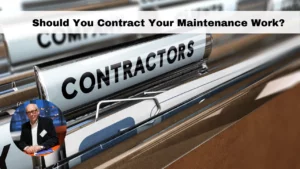How do you actually implement Reliability and Maintenance in your manufacturing plant?
What should you do first? What’s comes next?
This article will outline the implementation steps you need to take if you want to be successful in improving reliability and maintenance, so you can sustain improvement for years to come. .
Step I – Learn to Do the Right Things “Right”
“To tackle a problem from the wrong end can do nothing but harm” This was said by Confucius, a well known Chinese philosopher who lived around 551-479 BC.
Another way of saying this is that it is important to start off an improvement initiative by Do the Right Things, then you must learn to do them right.
Too often we turn this common sense statement upside down, we focus on doing things right but do not ask if this is the right thing to do.
I have written about this in many previous articles.
In step I and II you need to; See figure 1.
1. Define and agree on some fundamental principles.
2. Discover your improvement potential.
1. Define and agree on fundamental principles.
These principles include but are not limited to:
- Deciding if this is a Reliability Improvement initiative or cost reduction initiative. In my opinion the only right things to do is to increase Reliability to reduce Maintenance cost. It never works the other way around more than for temporary savings, which will then be followed by higher costs later. See case studies in the September and November column. Or go to www.idcon.com / Articles.
- The relationship between Operations, Maintenance and Engineering. Is it going to be a customer and supplier relationship or that of a partnership? As many readers know, my firm belief is that it has to be a true and equal partnership, the only customer you have is the one who buys your product. Consequently this improvement initiative is a joint venture between Operations, Maintenance and Engineering in improving Production Reliability and lowering Manufacturing Costs.
- Operators’ involvement. It makes sense to include operators in essential; care of equipment and also some adjustments and repairs.
- Life Cycle Cost. Shall Specification/Design of new equipment be based on Cost to buy, install, own and scrap equipment and include Reliability and Maintainability considerations, or shall lowest cost of buying and installing be emphasized more than cost of ownership?
- Problem identification. Are you going to classify problem such as production losses in Quality, Time or Speed, Equipment problems etc. by department, or are you going to define problems and solve them?
- Computer system support. Today it is difficult to find a plant that does not have a computer system to support effective maintenance, however you need to make sure that the system you have can support what you want to do.
2. Discover your improvement potential and increase your organization’s awareness.
Many organizations believe they are good but do not know what good really means. If you are the driver of this improvement initiative you yourself need to know what best practices are and how you can compare your organization’s performance to these practices. Next step is for you to start the selling of what you want to do and get some disciples to follow you.
A very cost effective way to do this is to bring in an outsider who in one presentation can present best practices and facilitate your organization to discover how good they are compared to how good they could be.
I know this can be very beneficial to do because I have done it myself in hundreds of organizations around the world.
Step 2 – Evaluate Based on Current Best Practices
After you have done the CBP (Current Best Practices) evaluation and discovered, understood and agreed upon your biggest improvement opportunities you shall not be surprised to find what you already knew, if you did not, it would be very bad.
The difference is that key people in your organization have discovered this together. You have mutually agreed upon an action plan that includes roles and responsibilities for both operations, maintenance and engineering. This is different than traditional audits.
Step 3 – Focus on Key Improvement Opportunities
Below is a summary on the key improvement opportunities and the common actions that often come up among the first steps in improvement plans. (see step III in the emerging pyramid)
- Maintenance Prevention
We thought we aligned well because we bought laser alignment tools, we discovered we do not align well. Action: check and realign five alignment points every shut down.
- Preventive Maintenance
We do too many PM inspections because we have never integrated what is done by Operators, Electricians, Lubricators and Mechanics. Action: Reevaluate all PM inspections using CMS – Condition Monitoring Standards and a system that can merge all PM activities under each equipment identity. For examples on CMS please contact me and I will send to you [email protected]
- Technical Data Base
We discovered that one major reason why planners do not plan, is that they have to spend too much time searching for parts and technical information because our Technical Data Base is not updated. Actions: Make sure computer system tags where parts are used for every withdrawal from store. Assign work orders to each craftsperson to update ten pieces of equipment in their domains every quarter.
- Planning and Scheduling
We discovered that we schedule poorly on a weekly and Daily basis and we do not plan at all because we are too reactive. Actions: Agree on guidelines for priorities and implement them. (There are only two priorities Do it now or latest date to complete work) Call me if you want an example [email protected] Agree on definitions on “Break- In” work and track by area and individual. Agree on cut off times for weekly, Daily, Shut Down and Outage schedules, track, record and follow up on “Break-In” jobs. Again call me if you want examples.
What I have described above are of course just examples on initial improvement initiatives for the first three months, but if you do these very basic things well you will see results and you will be ready for next steps.





